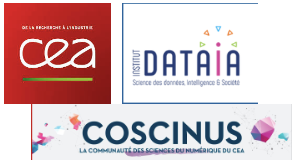GeoTS: A time series classification framework to identify geological formations
Shwetha Salimath, Centrale-Supelec
Lundi 16 décembre à 11h30, CEA-Saclay, Orme-des merisiers, Bat 709, salle Rubin
Studying the lithography of the Earth's subsurface in geoscience involves analyzing different geological formations to model and characterize reservoirs. This process uses drilled well measurements to connect specific geological formations or tops. Reservoir modeling is essential in geothermal, mineral mining, oil and gas, and carbon storage. Traditional well correlation algorithms are time-consuming and costly, but Deep Learning (DL) models have shown promising results. This paper presents GeoTS, a Python library that employs advanced time series classification DL models for well correlation. It uses drilling trajectory depth and gamma-ray well logs as inputs, predicting the depths of formations' tops. Gamma-ray signatures around these depths are extracted, cleaned, and clustered using Dynamic Time Warping (DTW) and machine learning models like HDBSCAN and OPTICS. The implementation includes various deep learning architectures (FCN, InceptionTime, XceptionTime, XCM, LSTM-FCN) and new models (LSTM-2dCNN, LSTM-XCM). The results indicate faster computation and higher accuracy than industry benchmarks, making this the first open-source benchmark for the well correlation task, to our knowledge.
Towards fast and scalable uncertainty quantification for scientific imaging
Tobias Liaudat, Irfu/Dedip
Vendredi 31 mai Jeudi 28 novembre à 11h30, CEA-Saclay, Orme-des merisiers, Bat 709, salle Rubin
Rôles de l'IA dans le cancer du sein pour le dépistage à partir de mammographies et pour la prédiction de la réponse à la chimiothérapie néoadjuvante à partir d’IRM
Frédérique Frouin, institut curie
Mardi 30 avril à 11h30, CEA-Saclay, Orme-des merisiers, Bat 709, salle Cassini
L’exposé portera dans un premier temps sur l’utilisation possible des méthodes d’intelligence artificielle pour le dépistage du cancer du sein à partir de mammographies, domaine pour lequel les données d’apprentissage sont nombreuses. Dans un second temps, à partir de notre expérience de recherche, nous montrerons comment dans des domaines beaucoup plus restreints, nous avons pu utiliser des outils d’IA pour tenter de mieux prédire la réponse à la chimiothérapie néoadjuvante et nous identifierons un certain nombre de difficultés qui limitent l’impact de ces outils à l’heure actuelle.

